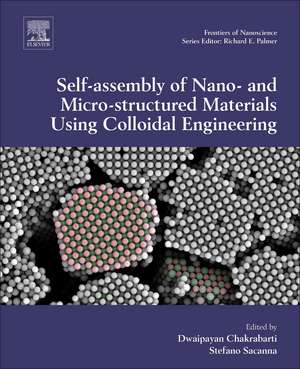Computational Modelling of Nanoparticles: Frontiers of Nanoscience, cartea 12
Editat de Stefan T. Bromley, Scott M. Woodleyen Limba Engleză Hardback – 13 sep 2018
This comprehensive, single resource is ideal for researchers who want to start/improve their nanoparticle modelling efforts, learn what can be (and what cannot) achieved with computational modelling, and understand more clearly the value and details of computational modelling efforts in their area of research.
- Explores how computational modelling can be successfully applied at the nanoscale level
- Includes techniques for the computation modelling of different types of nanoclusters, including nanoalloy clusters, fullerines and Ligated and/or solvated nanoclusters
- Offers complete coverage of the use of computational modelling at the nanoscale, from characterization and processing, to applications
Din seria Frontiers of Nanoscience
- 9%
 Preț: 792.39 lei
Preț: 792.39 lei - 23%
 Preț: 800.24 lei
Preț: 800.24 lei - 24%
 Preț: 871.47 lei
Preț: 871.47 lei - 9%
 Preț: 900.69 lei
Preț: 900.69 lei - 29%
 Preț: 987.03 lei
Preț: 987.03 lei - 29%
 Preț: 988.33 lei
Preț: 988.33 lei - 39%
 Preț: 872.24 lei
Preț: 872.24 lei - 23%
 Preț: 994.10 lei
Preț: 994.10 lei - 24%
 Preț: 987.98 lei
Preț: 987.98 lei - 24%
 Preț: 987.90 lei
Preț: 987.90 lei - 24%
 Preț: 850.26 lei
Preț: 850.26 lei - 9%
 Preț: 787.73 lei
Preț: 787.73 lei - 9%
 Preț: 700.26 lei
Preț: 700.26 lei - 9%
 Preț: 787.63 lei
Preț: 787.63 lei - 9%
 Preț: 790.23 lei
Preț: 790.23 lei - 9%
 Preț: 984.26 lei
Preț: 984.26 lei
Preț: 876.81 lei
Preț vechi: 1145.59 lei
-23% Nou
Puncte Express: 1315
Preț estimativ în valută:
167.80€ • 182.20$ • 140.95£
167.80€ • 182.20$ • 140.95£
Carte tipărită la comandă
Livrare economică 15-29 aprilie
Preluare comenzi: 021 569.72.76
Specificații
ISBN-13: 9780081022320
ISBN-10: 0081022328
Pagini: 351
Dimensiuni: 191 x 235 x 20 mm
Greutate: 0.82 kg
Editura: ELSEVIER SCIENCE
Seria Frontiers of Nanoscience
ISBN-10: 0081022328
Pagini: 351
Dimensiuni: 191 x 235 x 20 mm
Greutate: 0.82 kg
Editura: ELSEVIER SCIENCE
Seria Frontiers of Nanoscience
Public țintă
Researchers in both academia and working in R&D looking to learn more about what computational modelilng techniques can tell us about the properties of different nanomaterials.Cuprins
Introduction to Modeling Nanoclusters and Nanoparticles
1. How to Design Models for Ceria Nanoparticles: Challenges and Strategies for Describing Nanostructured Reducible Oxide
2. Simulating Heterogeneous Catalysis on Metallic Nanoparticles: From Under-Coordinated Sites to Extended Facets
3. From Nanoparticles to Mesoporous Materials
4. The DFT-Genetic Algorithm Approach for Global Optimization of Subnanometer Bimetallic Clusters
5. Clusters and Nanoparticles: The Experimental–Computational Connection to Understanding
6. Stress-Driven Structural Transitions in Bimetallic Nanoparticles
7. Modeling Realistic Titania Nanoparticle
8. DFT Modeling of Metallic Nanoparticles
9. Melting and Structural Transitions
1. How to Design Models for Ceria Nanoparticles: Challenges and Strategies for Describing Nanostructured Reducible Oxide
2. Simulating Heterogeneous Catalysis on Metallic Nanoparticles: From Under-Coordinated Sites to Extended Facets
3. From Nanoparticles to Mesoporous Materials
4. The DFT-Genetic Algorithm Approach for Global Optimization of Subnanometer Bimetallic Clusters
5. Clusters and Nanoparticles: The Experimental–Computational Connection to Understanding
6. Stress-Driven Structural Transitions in Bimetallic Nanoparticles
7. Modeling Realistic Titania Nanoparticle
8. DFT Modeling of Metallic Nanoparticles
9. Melting and Structural Transitions
